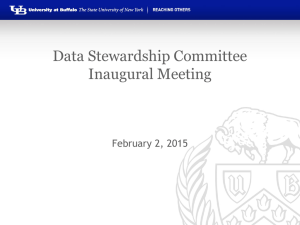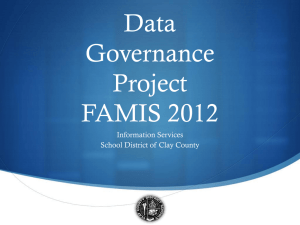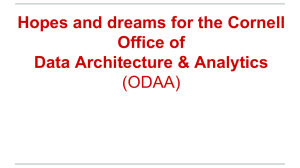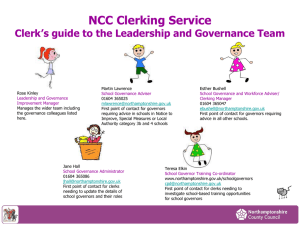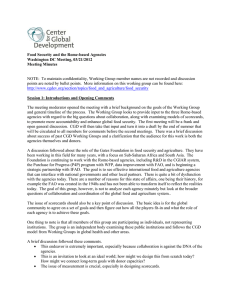2011 IM Symposium Template - 2014 Information Management
advertisement
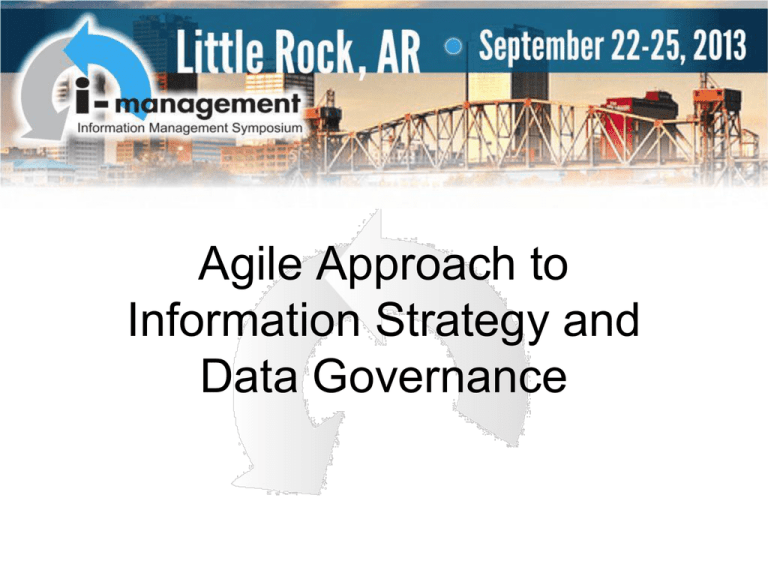
Agile Approach to Information Strategy and Data Governance Information Strategy and Data Governance WHY? Purpose: • To better understand how data and information management impacts corporate revenue, costs, and risk 2 Information Strategy and Data Governance Goal: • Use our data to drive growth, quality, and affordability Initial measurements for success: • Unclear (Activities taking place, but little consensus and even less transparency) 3 Information Strategy and Data Governance Objectives: • Provide approved consumers easy access to our data • Rapidly integrate data from other sources • Ensure data security and integrity • Ensure the integrity of our data storage systems and applications • Support the needs of key, strategic capabilities • Promote consistency and clarity across data subject area domains 4 Recommendations • Data governance and quality • Business glossary and metadata management • Application portfolio management • Trusted information hub • Project methodology for data integration • Disconnect business logic from hard-coding into applications or desk-top assets • Employ root cause problem-solving disciplines 5 Information Strategy and Data Governance Critical success elements to mature: •All HealthNow data elements assigned governance/stewardship at the operational, system, and reporting/analytical levels (Data Governance & Data Quality framework) •All information assets have governed terms and definitions and a published metadata map to illustrate data lineage (Business Glossary & Metadata Definitions to publish) •Grow into Policy based on business-driven deliverables 6 Payback • • • • • • • • Hard dollar gains Data reuse efficiencies Reduced maintenance costs/business risk Faster time to market - opportunity cost Rationalize application/database portfolio Empowered, less-stressed employees Improved customer experience Identify revenue reclamation vs. data manipulation/report generation 7 Actions • • • • • Arrange key staff training Organize trusted information hub Complete first-pass consolidation roadmap Appoint data stewards and data governors Disassociate business logic from key business subject areas • Implement performance management tools • Communicate information strategy throughout company 8 Data Governance & Quality Frameworks • 2012 – Identify and acknowledge existing data stewards and governors • 2013 – Empower and enable the data stewards and governors with process and technology accelerators • 2013 - Data quality and performance metrics visualized on scorecards – Scorecards based on bottom-up tactical considerations (e.g. data extract speed to market) and top-down strategic drivers (e.g. Grow customer retention while reducing costs) 9 Questions? 10 Scoped Deliverable • Centralize a trusted data set for reporting & analytics. • Settled Medical Claims was chosen to assist financial claim analytics. • Existing mainframe generated flat file was dimensionally modeled and made available to all analysts • Field elements were given business appropriate terms and source->target definitions (functional & technical) 11 Data Quality Scorecard for Improved Results Monitor data quality Identify problems, cleanse data Line of Business Manager Cleanse data Shared repository Data Stewards IT Developers 12 Scorecards/Trends for Line of Business Managers Browser-Based Scorecards • View and share • Drill down to detailed records • Take action to reduce impact on business • Monitor quality through trending and alerts Line of Business Manager 13 Settled Medical Claims Analytics • Supports end-user tools (Cognos, SAS, SQL). • Balancing routines to General Ledger. • Quality Scorecards enforcing Source->Target success • Built off of trusted source for medical claim financials • Provides opportunities for scaling and replacement • Business terms & definitions governed by business stakeholders • Incrementally developed in an agile framework 14 Information Strategy & Data Governance: Multi-Year Program Consensus Policy Publish Continuous monitoring and improvement Maintaining engagement and momentum Research and Development as standard practices (Prove, Prototype, Implement) • Iteratively grow an Information Ecosystem that satisfies multiple consumer needs while being minimally tethered to a single system or source • • • • 15 Questions? 16 Thank You George Yuhasz Director, Data Process and Governance yuhasz.george@healthnow.org 17
